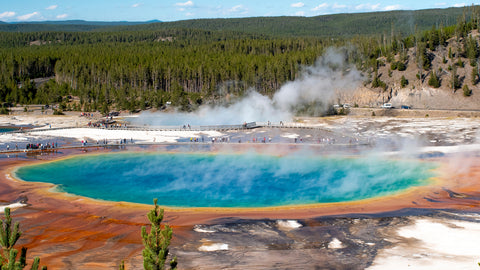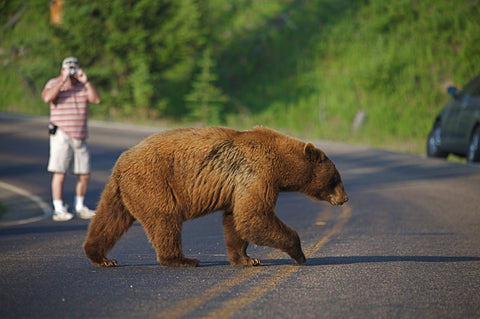Where is Yellowstone National Park
In the heart of the west is an American treasure - a gorgeous scenery of vast mountains, rushing waters, and sweeping forests - Yellowstone National Park. Yellowstone is teeming with wildlife, from plentiful birds and small mammals to large game animals and fish filled lakes. The park is mainly located in the northwest corner of Wyoming with a few swaths of land stretching into Idaho and Montana. The surrounding area is rugged, wild and natural. Only a few small towns are nearby, sprinkled throughout the country side.
How Big is Yellowstone National Park
Yellowstone National Park is as enormous as it is beautiful. The park covers over 3,470 square miles with 5 different entrances. Yellowstone encompasses more land than both Rhode Island and Delaware combined! The park’s vast array of features and natural area offers a little something for everyone. It is a paradise for climbers and hikers. The highest point in the park is Eagle Peak, reaching an elevation of 11,358 feet above sea level. The lowest point in the park is Reese Creek at 5,282 feet above sea level.

Yellowstone National Park Weather
The weather at Yellowstone National Park varies between elevations and season to season. In the spring and fall, the park is pretty chilly. Daily temperatures can range from 30°F to 60°F with overnight temps dipping into the single digits. Snowfall is not uncommon during these seasons. Things really cool down in winter. During the day the temperature can range from zero to 20°F. At night you can expect below freezing readings. Snow is expected in the winter. Yellowstone gets an average of 150 inches of snow a year, with higher elevations seeing twice that amount. Summertime at Yellowstone is picture perfect. The weather is usually between 70°F and 80°F during the day. Night time is cool and breezy. Thunderstorms routinely roll through in the afternoons.
When did Yellowstone become a National Park
Yellowstone is the first national park in the world, established on March 1, 1872. When the area was first explored, Truman Everts became separated from the expedition party. He survived over a month alone before being found and rescued. He later published a memoir of the ordeal, “Thirty-Seven Days of Peril.” His story is credited with sparking public interest in making Yellowstone a national park.

Things to do in Yellowstone National Park
There's a little something for everyone at this park. Here is List of Parks quick look at some of the most popular activities Yellowstone has to offer and the best times to take advantage of those opportunities.
Old Faithful
Old Faithful geyser is world famous, attracting thousands of visitors each year. Unlike most geysers, Old Faithful has predictable eruptions. There are several places posting predicted eruption times. Watch at the viewing area or weave through the Upper Geyser Basin and watch from the boardwalks. Visiting Old Faithful is great at any time of year.
Geothermal activity
There are around 10,000 geothermal features in Yellowstone. These include geyser basins, mud pots, hot springs, and fumaroles. These gorgeous and unique features aren’t found with this abundance anywhere else. Mammoth Hot Springs and Lower Geyser Basin are some of the most popular areas.
Fort Yellowstone
The US Army used to administer the park. You can still tour the Fort from that time, with 35 original structures still standing from the 1890s and early 1900s. The fort housed 324 soldiers. Some of these structures include concessions, officers' quarters, barracks, and stables.
Madison Campground
The Madison Campground is central to most park features. It’s at an elevation of 6,800 feet and near fishing hot spots. There are trails close by with Old Faithful only 16 miles south. Spring, summer and fall offer unique camping experiences and animal activity.
DeLacy Creek
The DeLacy Creek hiking trail is a must see. The trail is 7.4 miles long, leading to Shoshone Lake, through the DeLacy Meadows. You’ll find spectacular lake views, a beautiful beachfront and kayaking opportunities. Spring time is the key time to enjoy this trail.
Canyon Campground
The Canyon Campground is one of the most stunning and popular campsites in the park! The campsite sits at an elevation of 7,900 feet in the middle of a pristine pine forest. It’s close to the Cascade Lake, Mount Washburn, and Canyon Rim trails. You can camp year-round, but summer and fall are the highlight times.

Animals in Yellowstone
This park is home to a diverse assortment of animals, from tiny amphibians and mammals to large predators and prey. Elk, bighorn sheep and bison are some of the most iconic. You just might spy bobcats, bears or wolves. The park is also home to dozens of bird species, as well as reptiles, like the rubber boa, and many fish. The animal populations are most active and visible in the spring and fall.
Geology
Yellowstone is a highlight of active Earth processes and geological study. Explore canyons, calderas and mountain peaks. Visit hydrothermal geysers and hot springs. Yellowstone is home to roughly half the world's active geysers. You’ll also find petrified trees and other fascinating formations from volcanic activity. Spring and fall are the best times to survey Yellowstone’s geological wonders.
Yellowstone National Park webcams
You can enjoy the US National Park’s live feed at any time. Get a glimpse of Old Faithful erupting. Yellowstone also has eight static cameras that show the conditions at popular park spots year-round. These spots include Mammoth Hot Springs, Mount Washburn, and the Upper Geyser Basin.
Hiking Trails
There are more than 900 miles of hiking trails to explore via day hikes or backpacking excursions. Choose your view: forest, springs, mountain hills, lakes and more! The most temperate times for Hiking in Yellowstone are from April to May and between September and October.

When to go to Yellowstone National Park
The park is open all year round. The perfect time to go is totally up to you. Summer is the most popular time to visit the park. People enjoy boating, and fishing. There are hundreds of miles of trails to hike. Bears, bison, and elk are prevalent. There are ranger-led programs, hunting, and of course camping. Spring and fall are wonderful for folks that like flowers and foliage. Many animals are mating or migrating during these seasons, which makes for excellent wildlife watching. Don’t forget camping, fishing, boating and hiking. Winter snow makes for chilly fun. The park is the least crowded in winter. People enjoy skiing and sledding. There are plenty of ranger-led programs and you can even do an overnight at Old Faithful.
Must-Have things to bring to Yellowstone
There are a few essential items Our National Parks Visitors Guide suggest everybody should bring with them while adventuring in Yellowstone National Park. It’s important to be prepared with the proper equipment, food and safety supplies.
Water
Water is an absolute must! There are no water fountains on the trails and drinking from park lakes, streams and creeks is not recommended. You don’t want to risk dehydration and the health risks associated with it, so make sure to bring water with you.
Food/Snacks
While there are dining options at the park, it is recommended that you bring food too. This is especially true if you plan on camping. Make sure any food on the trail is properly secured to avoid encounters with bears.
Park Maps (physical and on phone)
Yellowstone is huge! It’s very easy to get lost. Make sure you put park maps on your phone. It is important to have physical copies too in case your phone experiences issues or is lost.

Proper Hiking Boots
Proper footwear will save you a lot of pain and trouble. Make sure you wear hiking boots or trail shoes that are already broken in to protect your feet from sprains, blisters and other injuries.
Jacket for Rain and cold weather Attire
Be prepared for inclement weather at Yellowstone. It could rain or snow (especially at higher elevations) at almost any time. You don't want to be caught up in a mountain storm without the proper gear.
Sunglasses, Sunscreen and warm weather Attire
Yellowstone sees sun year-round. Sunglasses will save your eyes from sunshine bouncing off bluffs. Avoid sunburn by bringing sunscreen. Apply liberally and often. Dress in clothes appropriate for warm weather to beat the heat.
Binoculars
To get the most out of your excursion, bring some binoculars (or purchase them at the park gift shop). You’ll get better views of distant landmarks and an almost up close look at elusive wildlife.
Bear Spray
The park is home to roughly 700 grizzly bears plus black bears. Bear spray is recommended by park rangers as a line of defense against an encounter. Bear spray is not allowed on airplanes. If you're flying, buy it when you arrive at your destination.

Bug Spray
The park is full of wildlife, and this includes insects! To keep the bugs at bay, you'll want to bring bug spray. Ticks, mosquitoes and flies are some pets you'll encounter without some insect repellant.
Toilet Paper and Plastic Bags
At parks, there is a “pack it in, pack it out” rule. This includes the call of nature. There are no toilets out on the trails. If you need to use the bathroom, you’ll need to supply the toilet paper. You’ll need to remove your waste and other trash. Plastic bags work great for this.
Where to stay in Yellowstone National Park
You’ve got a range of options when it comes to staying overnight at Yellowstone. There are dozens of campgrounds throughout the park. There are even some deep wilderness campsites for folks backpacking through the wilderness. For something nicer, you might try a cabin. There are many; like the Lake Lodge Cabins, which feature stunning waterfront views, and the rustic Roosevelt Lodge Cabins, which are close to Yellowstone’s Tower Falls. There are also several hotels and lodges for the plushest accommodations.
Food Nearby Yellowstone
After you’ve hiked to your heart's content, you might be hungry. The park has several delicious dining options if you’re interested in something other than campfire cooking. There are a few grills throughout the park, including Old Faithful Geyser Grill and Mammoth Hot Springs Terrace Grill. Wylie’s Canteen offers tasty classics. For finer dining, check out the Grant Village Dining Room or Canyon Lodge Eatery.

Airports near Yellowstone National Park
If you plan on taking a flight to get to Yellowstone, you’ve got some options. Major international airports nearby include Billings, Denver, and Salt Lake City. The closest major airport is Billings. It’s only 120 from the park’s northeast entrance. There are also a few smaller airports that are closer to the park; Bozeman, MT, Cody, WY, and Jackson, WY.

